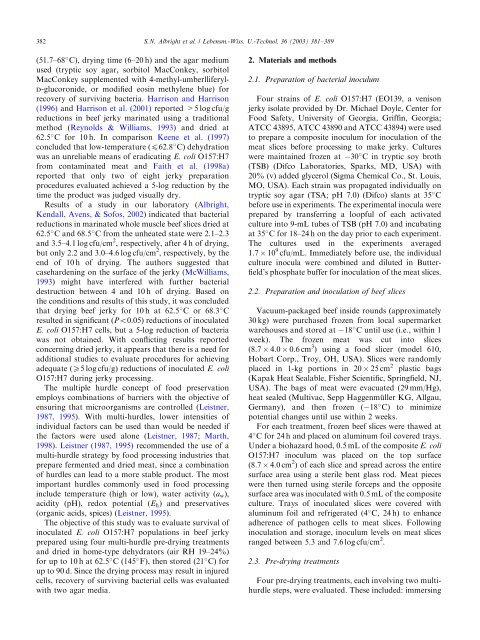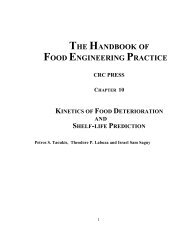Pretreatment effect on inactivation of Escherichia coli O157:H7 ...
Pretreatment effect on inactivation of Escherichia coli O157:H7 ...
Pretreatment effect on inactivation of Escherichia coli O157:H7 ...
Create successful ePaper yourself
Turn your PDF publications into a flip-book with our unique Google optimized e-Paper software.
382<br />
S.N. Albright et al. / Lebensm.-Wiss. U.-Technol. 36 (2003) 381–389<br />
(51.7–68 C), drying time (6–20 h) and the agar medium<br />
used (tryptic soy agar, sorbitol MacC<strong>on</strong>key, sorbitol<br />
MacC<strong>on</strong>key supplemented with 4-methyl-umberlliferyld-glucor<strong>on</strong>ide,<br />
or modified eosin methylene blue) for<br />
recovery <strong>of</strong> surviving bacteria. Harris<strong>on</strong> and Harris<strong>on</strong><br />
(1996) and Harris<strong>on</strong> et al. (2001) reported >5 log cfu/g<br />
reducti<strong>on</strong>s in beef jerky marinated using a traditi<strong>on</strong>al<br />
method (Reynolds & Williams, 1993) and dried at<br />
62.5 C for 10 h. In comparis<strong>on</strong> Keene et al. (1997)<br />
c<strong>on</strong>cluded that low-temperature (p62.8 C) dehydrati<strong>on</strong><br />
was an unreliable means <strong>of</strong> eradicating E. <strong>coli</strong> <strong>O157</strong>:<strong>H7</strong><br />
from c<strong>on</strong>taminated meat and Faith et al. (1998a)<br />
reported that <strong>on</strong>ly two <strong>of</strong> eight jerky preparati<strong>on</strong><br />
procedures evaluated achieved a 5-log reducti<strong>on</strong> by the<br />
time the product was judged visually dry.<br />
Results <strong>of</strong> a study in our laboratory (Albright,<br />
Kendall, Avens, & S<strong>of</strong>os, 2002) indicated that bacterial<br />
reducti<strong>on</strong>s in marinated whole muscle beef slices dried at<br />
62.5 C and 68.5 C from the unheated state were 2.1–2.3<br />
and 3.5–4.1 log cfu/cm 2 , respectively, after 4 h <strong>of</strong> drying,<br />
but <strong>on</strong>ly 2.2 and 3.0–4.6 log cfu/cm 2 , respectively, by the<br />
end <strong>of</strong> 10 h <strong>of</strong> drying. The authors suggested that<br />
casehardening <strong>on</strong> the surface <strong>of</strong> the jerky (McWilliams,<br />
1993) might have interfered with further bacterial<br />
destructi<strong>on</strong> between 4 and 10 h <strong>of</strong> drying. Based <strong>on</strong><br />
the c<strong>on</strong>diti<strong>on</strong>s and results <strong>of</strong> this study, it was c<strong>on</strong>cluded<br />
that drying beef jerky for 10 h at 62.5 C or 68.3 C<br />
resulted in significant ðPo0:05Þ reducti<strong>on</strong>s <strong>of</strong> inoculated<br />
E. <strong>coli</strong> <strong>O157</strong>:<strong>H7</strong> cells, but a 5-log reducti<strong>on</strong> <strong>of</strong> bacteria<br />
was not obtained. With c<strong>on</strong>flicting results reported<br />
c<strong>on</strong>cerning dried jerky, it appears that there is a need for<br />
additi<strong>on</strong>al studies to evaluate procedures for achieving<br />
adequate (X5 log cfu/g) reducti<strong>on</strong>s <strong>of</strong> inoculated E. <strong>coli</strong><br />
<strong>O157</strong>:<strong>H7</strong> during jerky processing.<br />
The multiple hurdle c<strong>on</strong>cept <strong>of</strong> food preservati<strong>on</strong><br />
employs combinati<strong>on</strong>s <strong>of</strong> barriers with the objective <strong>of</strong><br />
ensuring that microorganisms are c<strong>on</strong>trolled (Leistner,<br />
1987, 1995). With multi-hurdles, lower intensities <strong>of</strong><br />
individual factors can be used than would be needed if<br />
the factors were used al<strong>on</strong>e (Leistner, 1987; Marth,<br />
1998). Leistner (1987, 1995) recommended the use <strong>of</strong> a<br />
multi-hurdle strategy by food processing industries that<br />
prepare fermented and dried meat, since a combinati<strong>on</strong><br />
<strong>of</strong> hurdles can lead to a more stable product. The most<br />
important hurdles comm<strong>on</strong>ly used in food processing<br />
include temperature (high or low), water activity ða w Þ;<br />
acidity (pH), redox potential (E h ) and preservatives<br />
(organic acids, spices) (Leistner, 1995).<br />
The objective <strong>of</strong> this study was to evaluate survival <strong>of</strong><br />
inoculated E. <strong>coli</strong> <strong>O157</strong>:<strong>H7</strong> populati<strong>on</strong>s in beef jerky<br />
prepared using four multi-hurdle pre-drying treatments<br />
and dried in home-type dehydrators (air RH 19–24%)<br />
for up to 10 h at 62.5 C (145 F), then stored (21 C) for<br />
up to 90 d. Since the drying process may result in injured<br />
cells, recovery <strong>of</strong> surviving bacterial cells was evaluated<br />
with two agar media.<br />
2. Materials and methods<br />
2.1. Preparati<strong>on</strong> <strong>of</strong> bacterial inoculum<br />
Four strains <strong>of</strong> E. <strong>coli</strong> <strong>O157</strong>:<strong>H7</strong> (EO139, a venis<strong>on</strong><br />
jerky isolate provided by Dr. Michael Doyle, Center for<br />
Food Safety, University <strong>of</strong> Georgia, Griffin, Georgia;<br />
ATCC 43895, ATCC 43890 and ATCC 43894) were used<br />
to prepare a composite inoculum for inoculati<strong>on</strong> <strong>of</strong> the<br />
meat slices before processing to make jerky. Cultures<br />
were maintained frozen at 30 C in tryptic soy broth<br />
(TSB) (Difco Laboratories, Sparks, MD, USA) with<br />
20% (v) added glycerol (Sigma Chemical Co., St. Louis,<br />
MO, USA). Each strain was propagated individually <strong>on</strong><br />
tryptic soy agar (TSA; pH 7.0) (Difco) slants at 35 C<br />
before use in experiments. The experimental inocula were<br />
prepared by transferring a loopful <strong>of</strong> each activated<br />
culture into 9-mL tubes <strong>of</strong> TSB (pH 7.0) and incubating<br />
at 35 C for 18–24 h <strong>on</strong> the day prior to each experiment.<br />
The cultures used in the experiments averaged<br />
1.7 10 9 cfu/mL. Immediately before use, the individual<br />
culture inocula were combined and diluted in Butterfield’s<br />
phosphate buffer for inoculati<strong>on</strong> <strong>of</strong> the meat slices.<br />
2.2. Preparati<strong>on</strong> and inoculati<strong>on</strong> <strong>of</strong> beef slices<br />
Vacuum-packaged beef inside rounds (approximately<br />
30 kg) were purchased frozen from local supermarket<br />
warehouses and stored at 18 C until use (i.e., within 1<br />
week). The frozen meat was cut into slices<br />
(8.7 4.0 0.6 cm 3 ) using a food slicer (model 610,<br />
Hobart Corp., Troy, OH, USA). Slices were randomly<br />
placed in 1-kg porti<strong>on</strong>s in 20 25 cm 2 plastic bags<br />
(Kapak Heat Sealable, Fisher Scientific, Springfield, NJ,<br />
USA). The bags <strong>of</strong> meat were evacuated (29 mm/Hg),<br />
heat sealed (Multivac, Sepp Haggenm.uller KG, Allgau,<br />
Germany), and then frozen ( 18 C) to minimize<br />
potential changes until use within 2 weeks.<br />
For each treatment, frozen beef slices were thawed at<br />
4 C for 24 h and placed <strong>on</strong> aluminum foil covered trays.<br />
Under a biohazard hood, 0.5 mL <strong>of</strong> the composite E. <strong>coli</strong><br />
<strong>O157</strong>:<strong>H7</strong> inoculum was placed <strong>on</strong> the top surface<br />
(8.7 4.0 cm 2 ) <strong>of</strong> each slice and spread across the entire<br />
surface area using a sterile bent glass rod. Meat pieces<br />
were then turned using sterile forceps and the opposite<br />
surface area was inoculated with 0.5 mL <strong>of</strong> the composite<br />
culture. Trays <strong>of</strong> inoculated slices were covered with<br />
aluminum foil and refrigerated (4 C, 24 h) to enhance<br />
adherence <strong>of</strong> pathogen cells to meat slices. Following<br />
inoculati<strong>on</strong> and storage, inoculum levels <strong>on</strong> meat slices<br />
ranged between 5.3 and 7.6 log cfu/cm 2 .<br />
2.3. Pre-drying treatments<br />
Four pre-drying treatments, each involving two multihurdle<br />
steps, were evaluated. These included: immersing














